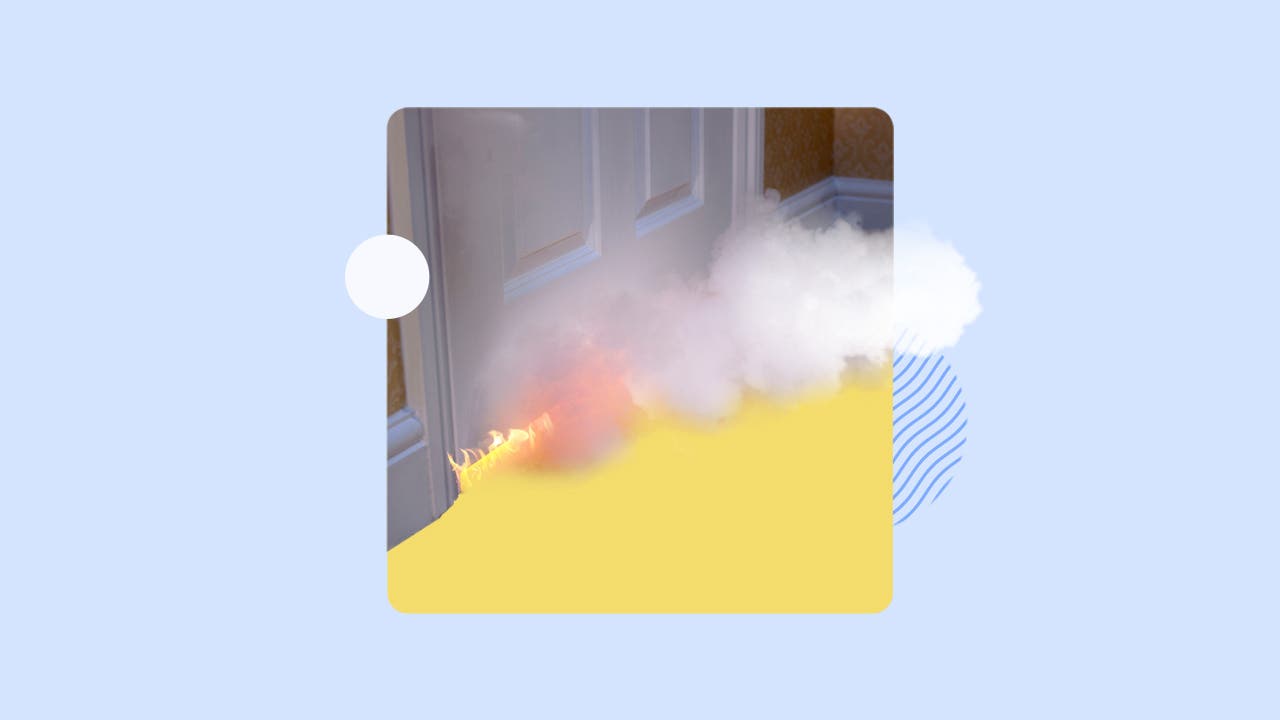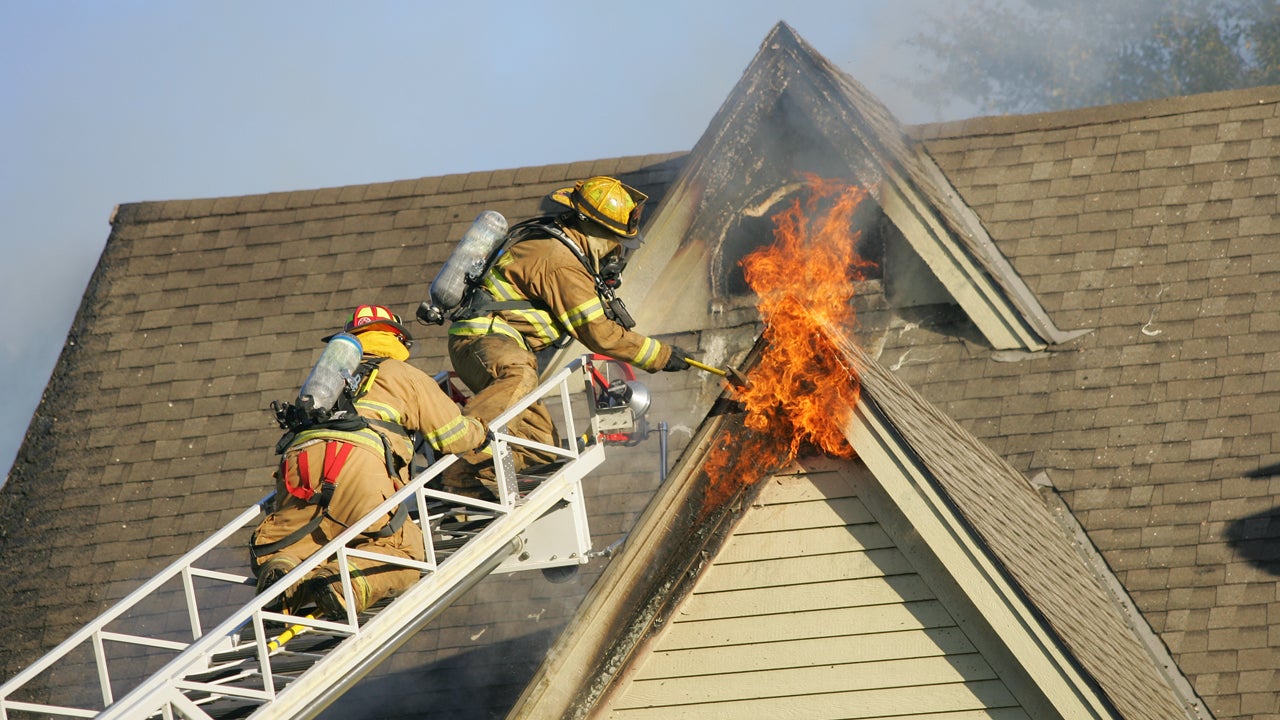U.S. house fire facts and statistics in 2025

A house fire can quickly spiral out of control. Something as small as a faulty socket, splash of grease or smoldering cigarette could cause hundreds, thousands or even hundreds of thousands of dollars of damage to your home. Most homeowners insurance policies cover fire damage, but it is important to know the limits of your policy.
House fire facts and statistics
House fires are more common than you may think. Fires can happen in any house, in any part of the country. According to the National Fire Protection Association (NFPA), almost one-quarter of the fires reported in 2023 occurred in home properties. The same year, a home structure fire was reported every 95 seconds. Consider these house fire statistics:
- As of January 2025, there have already been 213 home fire fatalities in the U.S. (U.S. Fire Administration)
- Cooking was the leading cause of home fires in 2022. Heating equipment was the second most common source of home fires. (U.S. Fire Administration)
- In 2023, a U.S. fire department responded to a fire somewhere in the country every 23 seconds on average. (NFPA – Fire Loss in the U.S.)
- In 2023, one fatal house fire occurred every three hours, while one home fire injury occurred every 52 minutes. (NFPA)
- Home fires in 2023 resulted in 2,890 civilian deaths. (NFPA)
- In 2022, home fires across the U.S. resulted in an estimated $11 billion in direct property damage. (NFPA)
- In 2023, the number of home fire deaths was 44 percent lower than in 1980. (NFPA)
- The most common month for house fires is December. In 2022, Christmas Day and Christmas Eve were the second- and third-most common days for cooking fires. (NFPA – December is Leading Month for U.S. Home Fires)
- Almost 22 percent of property claims in 2022 were for fire and lightning-related damage. (Insurance Information Institute)
- Just under 60 percent of home fire deaths in 2022 were caused by fires in properties with no smoke alarms, or smoke alarms that didn’t work properly. (NFPA – Smoke Alarms in US Home Fires)
Top 5 causes of house fires in the U.S.
House fires are caused by many things, but the majority in the U.S. stem from cooking. Data show that most home fires start in kitchens, which is also where most house fire injuries occur. This is especially true in apartments and multi-family homes: An estimated 69 percent of kitchen fires occurred in apartment and multi-family settings, whereas only 33 percent of kitchen fires started in single-family or two-family homes, based on a 2023 report from the NFPA. The other leading causes of house fires were heating equipment, electrical fires, intentional fires and fires from smoking materials.
While cooking fires may have caused the most injuries, they were not the deadliest. The same NFPA report found that from 2016 to 2020, fires caused by smoking materials like cigarettes and lighters caused the most home fire deaths. Specifically, 15,900 fires caused by smoking materials resulted in an average of 620 deaths. Fires caused by smoking materials also had the lowest numbers of direct property damage.
From 2016 to 2020, around 29,400 house fires (or 9 percent) in the U.S. were intentionally caused. Data from the NFPA show that intentional home fires have the lowest fatality rate out of the top five causes of home fires. Still, during the same four-year period, there were an average of 360 deaths per year and 820 injuries per year caused by intentional home fires.
The economic impact of house fires
The table below highlights the five most common causes of house fires and the average property loss per cause, according to data from the NFPA:
| Cause | Average number of house fires | Average property loss |
|---|---|---|
| Cooking | 166,430 | $1.2 billion |
| Heating equipment | 44,210 | $1 billion |
| Electrical distribution/lighting equipment | 30,740 | $1.4 billion |
| Intentional fire setting | 29,400 | $596 million |
| Smoking materials | 15,900 | $549 million |
Does homeowners insurance cover fires?
Home insurance is not a legal requirement, but if you have a mortgage, it’s likely that you are required to have it. Under most standard homeowners insurance policies, fire is one of the covered perils. Homeowners insurance typically covers damage from the fire itself, as well as smoke damage. For example, if a fire tore through your attic and destroyed the roof, your home insurance policy would likely pay for the repairs. It would also likely help pay to replace or repair the items that were stored in the attic if they were damaged by the flames or smoke.
However, in wildfire-prone areas, like some regions of California, your home insurance policy may exclude or limit wildfire damage. For this reason, experts recommend reading your policy documents thoroughly and speaking with a licensed insurance agent to be sure you have appropriate coverage in place.
After a fire, here is how your insurance policy can help financially protect the investment you’ve made in your home:
- Dwelling coverage: Dwelling coverage is the backbone of a home insurance policy and helps cover the cost of repairs and rebuilding a home’s physical structure.
- Other structures: Most home insurance policies also cover detached structures on your property, like fences and gazebos, in case of fire damage. Other structures are typically covered for up to 10 percent of your dwelling limit.
- Personal property: Homeowners insurance will typically cover damage to your personal property in case of fire damage. If you have especially valuable items, you may need to add a scheduled personal property endorsement to be fully protected.
- Liability coverage: Liability coverage could help if you are found negligent for someone else’s fire-related injuries at your home.
- Additional living expenses coverage: Also known as loss of use coverage, this part of a home insurance policy can help with unexpected hotel, food, laundry and other costs that stem from your home being uninhabitable after a covered loss.
It’s important to note that intentionally set fires won’t be covered by a home insurance policy. However, if you have a mortgage on your home and your home is intentionally burned and destroyed, your mortgage lender will likely receive the payout from your insurance company. The specifics of this scenario are usually spelled out in the mortgagee clause of your home insurance policy.
House fire safety tips
Hearing your home’s fire alarm go off is never a comforting sound. Knowing what to do ahead of time is the key to staying safe in the event of a fire. Bankrate compiled some fire safety tips from the American Red Cross:
- Identify essential items before evacuating: Think about the items of value or importance that you would want to take with you in the event of a fire, like passports and sentimental belongings. Make a list of these items or put them in the same area so you can easily grab them if you need to evacuate.
- Alert your household members: If you smell smoke, yell “Fire!” to alert others.
- Crawl to safety: If there’s smoke in the air, crawl on the floor below the smoke to the nearest exit.
- Keep away from warm doors: Never open a door if the door itself or doorknob is warm to the touch.
- Call the fire department as soon as you can: Once you are safely away from your home, use your mobile phone to dial 911. If you left your phone inside, get to a neighbor’s house as quickly as you can and ask them to call.
- Stop, drop and roll: If your clothing is on fire, do not run, as running can worsen the flames. Instead, drop to the ground and roll until the flames are extinguished.
If your exit routes are blocked by flames, stay where you are and close the doors. If you’re able to, grab a wet towel and place it beneath the door. Get to a window and wave something brightly colored and shout to signal your neighbors for help.
How to prevent a house fire
When it comes to house fires, prevention is the best cure. Practicing fire safety can help keep your home safe from would-be flames:
- Install smoke alarms: Smoke alarms can save your life in the event of a house fire. If your home does not have smoke alarms, you can easily install them yourself with a ladder and a little DIY spirit. Put smoke alarms in the kitchen, living spaces and bedrooms, and connect them so they will all sound when one alarm is triggered.
- Keep your smoke alarm batteries charged: Remember to test your smoke alarms regularly and make sure the batteries are still functional.
- Have a fire escape plan: Draw a blueprint of your home and designate at least two points of exit. If you have children, make sure they know the escape plan and feel comfortable getting out quickly. As part of your plan, you should also set a meeting space away from the home so you can make sure everyone is accounted for.
- Cook cautiously: Most home fires start in the kitchen. Don’t walk away when the stove is on, avoid wearing loose clothing that could ignite and keep flammable items, like dish towels and food wrappers, away from burners. If you are cooking with oil, make sure to clean up any leftover grease as soon as it cools.
- Keep matches and lighters away from kids: If you have children in your home, make sure to keep matches and lighters in a drawer or somewhere out of reach.
- Check your outlets, furnace and gas pipes regularly: You can check your outlets by feeling the plates for heat, looking for smoke and checking for frayed wires by removing the cover. If any of the outlets in your home are loose or no longer hold a plug tightly, it’s a good idea to replace them. You can schedule a professional to examine your furnace and gas pipes for you, optimally on a yearly basis.
- Know how to use your fire extinguisher: Your fire extinguisher can be the difference between minor cosmetic damage and a total home rebuild. Be sure you feel comfortable using it in an emergency.
Frequently asked questions
You may also like

Does homeowners insurance cover fire damage?

California’s new insurance regulations tested by L.A. wildfires




